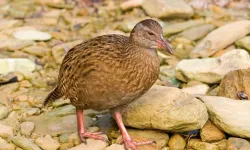Claim False
→ The image was originally shared by a Russian user claiming that it was created using artificial intelligence tools.
→ According to a scan of AI image detection tools, 85.1% of the time the image was created using AI tools.
→ Snakes are not migratory and large clusters of snakes are rare. There is no snake migration movement known as the Nile Migration.
Created with Image Manipulation Tools
When one looks carefully at the image in the post, the unusual order in the arrangement of the snakes raises doubts as to whether the image reflects reality. The unnaturalness of the lines in the image and the artificiality in details such as light and shadow also increase this suspicion. When the comments under the post are read, it is seen that many users state that the image is not real. When the shared image is searched through Google Lens with the reverse image search method, it is possible to see that it was shared on different social media platforms with the title "Nile Migration" on almost the same dates.
When the Nile Migration search on Google is performed by specifying a time interval, it is seen that the first post was shared by a Facebook user on April 20, 2024 with the following note:
A Russian Al user imaginatively designed an image about the migration of snakes. Millions of snakes are migrating, not in the desert, but in the Nile, on their tails, heads erect, like an army in formation. And at the front is a giant leader. General Cobra! It's fantastic. But also very traumatic. Many people thought this image was real and shared it with fear and trembling.
From April 21 onwards, it can be seen that the image was shared intensively through different sources. To check whether the image was created with manipulation tools, Is It AI? found that 85.1% of the images were created using artificial intelligence (AI) tools. This result supports the explanation written in the first post of the image on Facebook:
Snakes Are Not Migratory Animals
A basic survey of snakes, using some basic sources such as Britannica and National Geographics, reveals some characteristics that apply to many snake species. The first of these is that most snake species live in a specific region and do not migrate over large distances. Of course, there are exceptions to this rule. Some species may travel short distances seasonally or, in rare cases, move in large clusters due to environmental factors. One rare migration is the snake migration that occurs twice a year in the Shawnee National Forest in the United States. In the spring, along with other reptiles and amphibians, snakes migrate from the limestone cliffs of the forest to LaRue Swamp, and in the fall they migrate in reverse. This path is also called the Snake Trail:
In a study on rare snake migrations, there is no evidence of a snake migration called the Nile Migration.
Another striking feature of the image is the migration of a large cluster of snakes. However, it is also rare for snakes to live and move in large clusters. Most snakes are solitary creatures and do not live in large groups. They focus 70% of their mostly solitary existence on hunting, capturing and digesting their prey. They have short seasonal activities such as mating and egg laying. This means that snakes spend most of their lives alone and only come together for short periods for reproduction. In rare cases, environmental factors such as drought or flooding can cause large clusters of snakes to come together.















